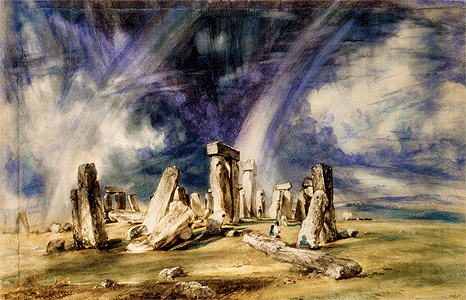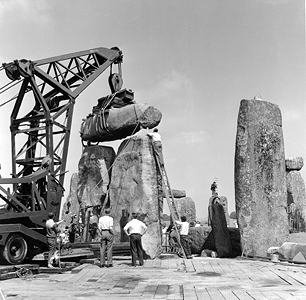Stonehenge


Above left: "Stonehenge", painting by John Constable, (English Royal Academy, 1835). Above right: Stonehenge actually being rebuilt in 1958; see https://www.youtube.com/watch?v=kU1f0_jf6AE
Built by an unknown prehistoric culture, although popularly credited to the Celtic high priests, the Druids, the 'stones of the ancestors' is among many uses speculated by "experts"; the original use is unknown. The iconic monument is located on a plain above the River Avon near Amesbury, in Wiltshire, England. It is not well known that during the 1950's the monument was subject of much controversial conjectural reconstruction.
Stonehenge was built in several different phases between about 3000 and 2000 BCE. The first phase was a large circular ditch and bank lined just inside the ditch with a circle of 2-metre-high bluestones. Later, these bluestones were moved inward toward the circle center, and the bigger structure of mortise-and-tenon "sarsen trilithon" boulders were constructed around them.
Recent controversial scientific discoveries indicate that Stonehenge may have started as a stone circle in western Wales and was then dismantled and rebuilt 280 kilometres (174 miles) away at its current location on the Salisbury plain. A team of archaeologists, led by Mike Parker Pearson at University College London, has uncovered the remains of what appears to be Britain's third-largest stone circle, 110 metres (361 feet) in diameter, in the Preseli hills of west Wales, created between 3600 and 3200 BCE. Parker Pearson's team revealed evidence the Welsh circle was composed of bluestones extracted from nearby quarries of Preseli hills. There is strong evidence these bluestones were then moved by people to the Salisbury plain site, c. 3000 BCE at the beginning of Stonehenge phase one construction.
Parker Pearson concludes that Stonehenge was constructed to commemorate and venerate the ancestors of the original Welsh people who moved to and then lived at Stonehenge. In their religion the bluestones could have been the embodiment of the original Welsh ancestors.
Elevation is c.101 meters (334 feet) above sea level.
Materials: Megalithic stone uprights and lintels, 80 bluestone monoliths brought from distant Wales (ancient Ireland).
Data for CG model:
1. https://www.google.com/search?q=stanton+drew+plan&tbm=isch&tbo=u&source=univ&sa=X&ved=0ahUKEwi9xILKu4vaAhVMx2MKHVicAzgQsAQILw&biw=1276&bih=1484
2. https://www.le.ac.uk/has/ps/past/past28.html
3. https://principia-scientific.org/a-modern-reconstruction-the-truth-about-stonehenge/
4. https://www.english-heritage.org.uk/visit/places/stonehenge/history-and-stories/history/research/
5. Pearson, M., Pollard, J., Richards, C., Welham, K., Kinnaird, T., Shaw, D., . . . Edinborough, K. (2021); The original Stonehenge? A dismantled stone circle in the Preseli Hills of west Wales. Antiquity, 95(379), 85-103. doi:10.15184/aqy.2020.239
https://youtu.be/6vRp6vE6pl4
6.Youtube: Stonehenge: The Lost Circle Revealed | BBC Documentary: "Professor Alice Roberts follows a decade-long historical quest to reveal a hidden secret of the famous bluestones of Stonehenge."
https://youtu.be/6vRp6vE6pl4









